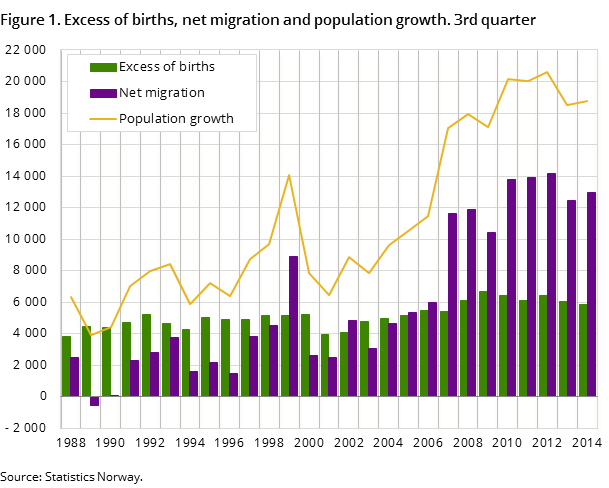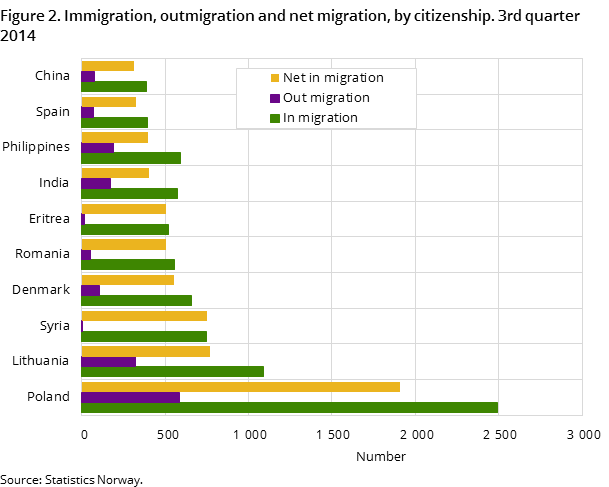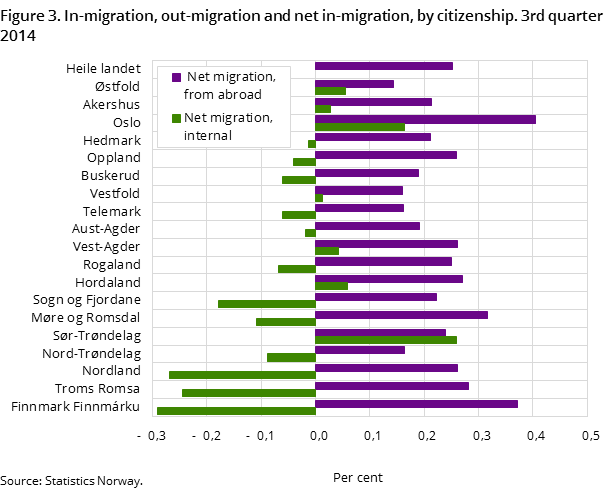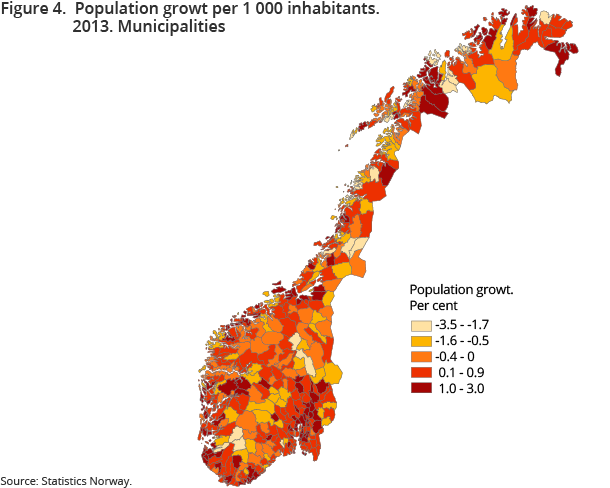Content
Published:
This is an archived release.
Population growth in 3rd quarter still high
The population increased by 18 800 during the third quarter and reached 5 156 450 on 1 October. This growth was very close to the average for the last eight years. Net migration was 300 higher than this average, while the birth surplus was 300 lower.
| 3rd quarter 2014 | 3rd quarter 2013 | Changes from same period previous year | |
|---|---|---|---|
| Number | |||
| Population at the beginning of the quarter | 5 137 679 | 5 077 798 | 59 881 |
| Births | 15 579 | 15 730 | -151 |
| Deaths | 9 747 | 9 704 | 43 |
| Excess of births | 5 832 | 6 026 | -194 |
| Immigration | 21 111 | 22 816 | -1 705 |
| Emigration | 8 171 | 10 340 | -2 169 |
| Net migration, immigration and emigration incl | 12 940 | 12 476 | 464 |
| Population growth | 18 772 | 18 502 | 270 |
| Population at the end of the quarter | 5 156 451 | 5 096 300 | 60 151 |




A total of 15 550 children were born in the 3rd quarter, while 9 750 persons died. The birth surplus of 5 800 was 200 lower than for the 3rd quarters of the last six years, but was higher than in the years before 2008. The lower surplus was mainly due to slightly fewer children being born.
So far this year, 45 700 children have been born; some 100 more than last year. The number is lower than for the years 2008 through 2010 when the corresponding quarters saw up to 47 400 children being born; 1 700 more than now. A total of 29 900 persons have died so far this year, which is almost 1 000 fewer than last year, and 3 600 or 11 per cent fewer than at the turn of the century, when 33 500 had died by the end of the third quarter. The birth surplus of 15 800 so far is therefore 1 100 higher than last year, and higher than for many years, apart from 2009 and 2010.
The population increased by 47 400 in the first three quarters of 2014, which is 2 400 more than last year, but still lower than some of the years preceding 2013. In particular, Oslo had a large increase of 11 200 persons; 2 200 higher than last year.
Somewhat fewer in- and out-migrations in the quarter; out-registrations
A total of 21 100 persons migrated from abroad, while 8 200 migrated from Norway. This gave a net migration of 12 900, which is 500 higher than in the same quarter last year, but almost 1 200 lower than in the years 2010-2012. Before 2006, the figures were very much lower, only reaching between 2 000 and 4 000 for some of the years. The in-migration of 21 100 was 1 700 lower than last year, while the out-migration of 8 200 was 2 00 lower.
A total of 1 500 or 18 per cent of the out-migrations apply to persons who have emigrated perhaps a long time ago, but who have not reported their migration to the population register. The Tax Administration carries out a continuous check of the Central Population Register, resulting in an out-registration of these persons. These out-registrations in the third quarter were fewer in number than earlier, so the lower number of out-migrations is partly due to this.
Large net migration by Polish, Lithuanian and Syrian citizens
Once again, Poles continued to make up the largest group of those with foreign citizenship who in-migrated to Norway. The Poles constituted as many as the next two largest groups, Swedish and Lithuanian citizens, combined. The fourth largest group in the third quarter was the Syrian citizens, and the biggest change from last year to now was the increase from 150 to 750 in net migration of Syrian citizens. On the other hand, the net migration of Lithuanian citizens in the third quarter was reduced from 1 300 last year to 800 now. The corresponding fall for Poles was from 2 300 to 1 900 and for Somali citizens from 600 to 300. The net migration of 7 300 European citizens constituted 60 per cent of the net migration of those with foreign citizenship.
The 1 200 Swedish citizens once again were the largest group of foreign citizens to leave Norway; twice as many as the 600 Poles. Swedish citizens therefore ended up with a net migration of only 100. The net migration of citizens from the South European countries experiencing high unemployment, such as Spain, Portugal, Italy and Greece, remained at the same level, reaching 800, while last year it reached 850.
Highest internal migration surplus in Østfold/Akershus/Oslo
Seven counties had an internal migration surplus, while twelve had a loss. The Østfold/Akershus/Oslo area had the largest surplus with 1 400 combined. Seen in relation to the population size, Sør-Trøndelag had the largest surplus. The three northernmost counties had a combined loss of 1 300, and compared to the population size, the loss was particularly high there.
Oslo had the largest birth surplus in the first three quarters
So far in 2014, 7 800 children have been born in Oslo, while the number of persons who have died was 2 900, resulting in a birth surplus so far of 4 900. The number of deaths in the two inland counties Hedmark and Oppland has been 350 higher than the number of births.
Oslo has the highest number of births compared to the population size, while Hedmark has the lowest. Hedmark and Oppland have the highest relative number of persons who have died, and Oslo, Rogaland and Akershus have the lowest.
The statistics is published with Population.
Contact
-
Statistics Norway's Information Centre
E-mail: informasjon@ssb.no
tel.: (+47) 21 09 46 42
